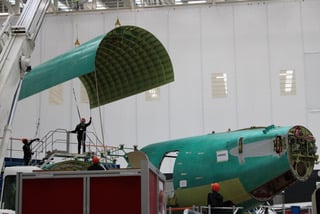Click Here to View This Page on Production Frontend
Click Here to Export Node Content
Click Here to View Printer-Friendly Version (Raw Backend)
Note: front-end display has links to styled print versions.
Content Node ID: 408086
The last of three E-7 Wedgetail AEW&C aircraft being supplied to the UK Royal Air Force arrived in the country last week, for conversion from the Boeing 737NG airframe. Principles described the program in some detail last Friday during a briefing at the Royal International Air Tattoo (RIAT), held just before the Farnborough Airshow.
The RAF ordered five E-7s in 2019 to replace its aging E-3 Sentry fleet. It reduced the order to three aircraft last year, in a British defense review. Two of them are second-hand airliners, the third is new-build. The E-7s are due to enter service in 2024. Until then, there will be a capability gap because the RAF has just retired its last three flyable E-3s and sold them to Chile.
Air Commodore Alex Hicks, the RAF’s senior responsible officer, talked frankly about the disruption caused by the decision to cut the order. “We had to start afresh on the contracting…there have been a lot of distractions,” he said. A late decision to base the aircraft at RAF Lossiemouth in Scotland rather than RAF Waddington, the RAF’s ISTAR hub and E-3 Sentry base, didn't help the problem. The reason was to achieve synergies with the RAF’s fleet of nine P-8 Poseidon ASW aircraft, which is also based on the Boeing 737 airframe.
The aircraft are being converted by STS Aviation Services at Birmingham Airport. STS is a global MRO but had not previously tackled a complex military conversion in the UK. So eyebrows were raised about the choice, which was Boeing’s to make, although validated by the UK MOD’s Defence Equipment and Support agency.

Boeing originally negotiated with Marshall Aerospace for the work to be done at its Cambridge facility, where the privately-owned company has done military conversions and overhauls for many years, notably on the C-130 Hercules. But “it didn’t work out,” said Anna Keeling, v-p and managing director of Boeing UK. AIN understands that the plan was to award Marshall a sole-source contract. When the talks failed, a competition was held, and STS emerged as the winner.
Keeling said that although this was a complex and heavy modification program, it had been quickly set up by a blended team of about 100 people split equally between Boeing and STS employees. The latter are qualified mechanics who have undergone an eight-week training course. The team is performing the structural modifications, including the removal, modification, and reinstallation of the entire Section 46 of the fuselage to accommodate the Northrop Grumman “Top Hat” multi-role electronically scanned array (MESA). Keeling said the process involved the drilling of 30,000 holes. Overall, the conversion requires the addition of 1,000 wire harnesses and the modification of 150 more. STS has already performed 100,000 hours of touch labor on the aircraft, the first of which arrived at Birmingham in January 2021. 
Meanwhile, Boeing employees are working on the mission integration systems at the company’s Oklahoma upgrade and modification center and Northrop Grumman has completed and tested the first MESA at its Baltimore facility. Hicks noted that Northrop Grumman had not produced a MESA for some years; Boeing sold a total of 14 Wedgetails to Australia, Turkey, and Korea between 2009 and 2015. He said that the RAF’s MESAs will be modernized, for example, by consolidating LRUs onto a single card. “MESA is not just a radar, it’s a sensor,” he added.
Hicks looks forward to potential transatlantic synergies, now that the U.S. Air Force has also decided to buy E-7s as an E-3 replacement. “U.S. crews will participate in our development testing and evaluation. They want to go operational as soon as possible,” he said.